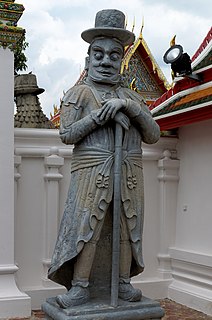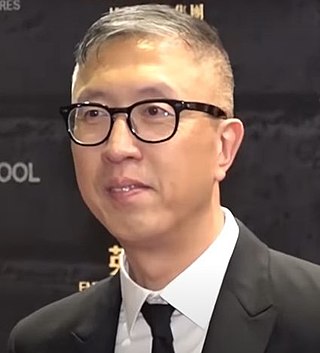Related Research Articles

Farang is a Persian word that originally referred to the Franks and later came to refer to Europeans in general. The word "Farang" is a cognate and originates from Old French: "franc".
Mackem, Makem or Mak'em is the informal nickname for residents of and people from Sunderland, a city in North East England. It is also a name for the local dialect and accent ; and for a fan, whatever their origin, of Sunderland A.F.C. It has been used by the people of Sunderland to describe themselves since the 1980s, prior to which it was mainly used in Tyneside as a disparaging exonym. Prior to the 1980s, the people of Sunderland were known as Geordies, in common with the rest of the North East. An alternative name for a Mackem is a Wearsider.
Isan or Northeastern Thai refers to the local development of the Lao language in Thailand, after the political split of the Lao-speaking world at the Mekong River, with the left bank eventually becoming modern Laos and the right bank the Isan region of Thailand, after the conclusion of the Franco-Siamese War of 1893. The language is still referred to as Lao by native speakers. As a descendant of the Lao language, Isan is also a Lao-Phuthai language of the Southwestern branch of Tai languages in the Kra-Dai language family, most closely related to its parent language Lao and 'tribal' Tai languages such as Phuthai and Tai Yo. Isan is officially classified as a dialect of the Thai language by the Thai government; although Thai is a closely related Southwestern Tai language, it actually falls within the Chiang Saen languages. Thai and Lao are mutually intelligible with difficulty, as even though they share over 80% cognate vocabulary, Lao and Isan have a very different tonal pattern, vowel quality, manner of speaking and many very commonly used words that differ from Thai thus hampering inter-comprehension without prior exposure.

Geert Ludzer Mak is a Dutch journalist and non-fiction writer.

MAKS is an international air show held at Zhukovsky International Airport, the home of the Gromov Flight Research Institute in Zhukovsky, 40 km (25 mi) southeast of Moscow, Russia. The event was organized by the Russian Ministry of Industry and Trade until 2009, more recently by the Government of Moscow and Aviasalon. The first show, Mosaeroshow-92, was held in 1992. Since 1993, the air show was renamed as MAKS and is held biennially on odd years.

Egyptians speak a continuum of dialects. The predominant dialect in Egypt is Egyptian Colloquial Arabic or Masri/Masry, which is the vernacular language. Literary Arabic is the official language and the most widely written. The Coptic language is used primarily by Egyptian Copts and it is the liturgical language of Coptic Christianity.

The Yavanajātaka of Sphujidhvaja is an ancient text in Indian astrology.

Felix Chong Man-Keung is a Hong Kong screenwriter, film director and actor.

Bangjong Pisanthanakun is a Thai filmmaker and screenwriter. He saw early success with his first two films, Shutter (2004) and Alone (2007), both horror films that he co-directed and co-wrote with Parkpoom Wongpoom. He also directed the 2013 comedy horror romance film Pee Mak, which became Thailand's highest-grossing film of all time, and the 2021 horror film The Medium, which was a commercial and critical success in South Korea. In addition to horror films, Bangjong directed the romance films Hello Stranger (2010) and One Day (2016).
Ai-Cham is a Kam–Sui language spoken mainly in Diwo 地莪 and Boyao 播尧 Townships, Jialiang District, Libo County, Qiannan Prefecture, Guizhou, China. Alternative names for the language are Jiamuhua, Jinhua and Atsam. Fang-Kuei Li first distinguished the language in 1943. Nearby languages include Bouyei and Mak. However, Yang (2000) considers Ai-Cham and Mak to be different dialects of an identical language.

In systemic functional grammar (SFG), a nominal group is a group of words which represents or describes an entity, for example "The nice old English police inspector who was sitting at the table with Mr Morse". Grammatically, the wording "The nice old English police inspector who was sitting at the table" can be understood as a nominal group, which functions as the subject of the information exchange and as the person being identified as "Mr Morse".
The Kam–Sui languages are a branch of the Kra–Dai languages spoken by the Kam–Sui peoples. They are spoken mainly in eastern Guizhou, western Hunan, and northern Guangxi in southern China. Small pockets of Kam–Sui speakers are also found in northern Vietnam and Laos.

The Chimbu–Wahgi languages are a language family sometimes included in the Trans–New Guinea proposal.
Mak may refer to:
Mak nyah, alternatively spelled maknyah, is a Malay vernacular term for trans women in Malaysia. It arose in the late 1980s in order to distinguish trans women from other minorities.

The MAK – Museum of Applied Arts is an arts and crafts museum located at Stubenring 5 in Vienna's 1st district Innere Stadt. Besides its traditional orientation towards arts and crafts and design, the museum especially focuses on architecture and contemporary art.
The Mak language is a Kam–Sui language spoken in Libo County, Qiannan Prefecture, Guizhou, China. It is spoken mainly in the four townships of Yangfeng, Fangcun (方村), Jialiang (甲良), and Diwo (地莪) in Jialiang District (甲良), Libo County. Mak speakers can also be found in Dushan County. Mak is spoken alongside Ai-Cham and Bouyei. The Mak are officially classified as Bouyei by the Chinese government.
The Bikwin–Jen or simply the Jen languages form a branch of the Adamawa family. They are spoken in and around Karim Lamido LGA in Taraba State, and in other nearby states of eastern Nigeria.

Nasi tempong is an Indonesian rice dish, typical food of Osing people in Banyuwangi, consists of steamed rice with boiled vegetables, tofu, tempeh, corn fritter and fried ariid catfish. This rice dish served with kencur sambal or terasi sambal.
References
- ↑ Mak at Ethnologue (18th ed., 2015)